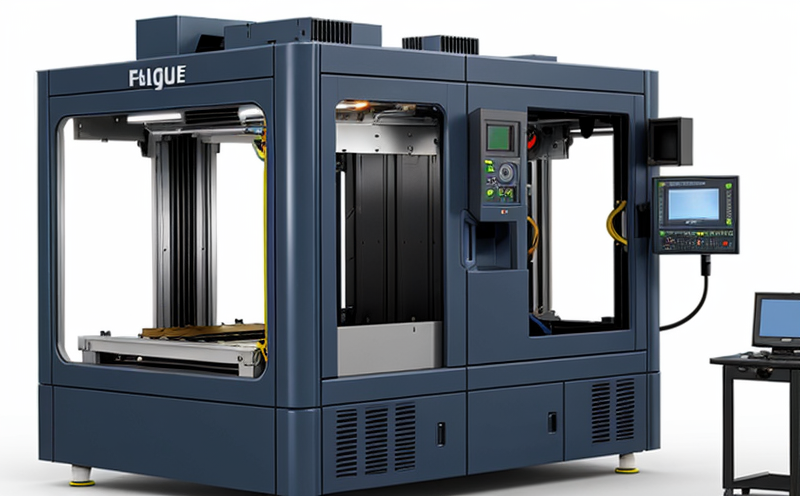ASTM E2714 Fatigue Testing with Constant Life Diagrams
The ASTM E2714 standard provides a comprehensive framework for fatigue testing of parts and assemblies produced through additive manufacturing (AM) processes. This method is crucial in ensuring the reliability and longevity of printed components, which are increasingly being used in critical applications across various sectors such as aerospace, automotive, and medical devices.
The ASTM E2714 standard focuses on cyclic loading conditions where the number of cycles to failure or the life of a part under constant amplitude loading is determined. This testing method helps engineers understand how parts will behave over extended periods in real-world environments. The test procedure involves subjecting specimens to fatigue cycles, monitoring their behavior, and recording data that can be used to predict the service life of components.
One of the key aspects of ASTM E2714 is the use of constant life diagrams (CLDs). CLDs provide a graphical representation of how the stress amplitude affects the number of cycles to failure. This information is invaluable for manufacturers who need to ensure that their products can withstand expected operational stresses without failing prematurely.
The testing process typically involves creating specimens using AM technologies, subjecting them to cyclic loading in a controlled environment, and monitoring the behavior under different stress levels. Specimen preparation is critical; it must be done according to the ASTM E2714 guidelines to ensure accurate test results. This includes selecting appropriate materials, designing the specimen geometry, and ensuring that any post-processing steps do not alter the integrity of the material.
The equipment used for this type of testing includes specialized fatigue testers capable of applying controlled cyclic loads. These machines are equipped with sensors to monitor stress and strain during each cycle. Data acquisition systems capture these measurements in real-time, providing detailed insights into how components behave under various loading conditions.
Following the completion of the test cycles, engineers analyze the collected data to determine the fatigue life or number of cycles to failure for different stress levels. This information is then used to establish design parameters that ensure parts can operate safely and effectively in their intended applications.
The ASTM E2714 method enhances product development by providing critical insights into material behavior under cyclic loading conditions. It helps manufacturers make informed decisions about selecting appropriate materials, optimizing designs, and ensuring compliance with industry standards. By using this testing methodology, companies can reduce the risk of failure in their products, which is particularly important for industries where reliability and safety are paramount.
The process also aids in identifying potential weaknesses or areas that require further investigation during product development. Engineers can use the results from ASTM E2714 to refine designs, improve manufacturing processes, and enhance overall quality assurance practices. This leads to more robust products capable of meeting stringent performance requirements.
Overall, ASTM E2714 fatigue testing with constant life diagrams is a vital tool in ensuring the reliability and longevity of additive manufactured parts. It provides valuable data that supports informed decision-making throughout the product lifecycle, from initial design phases through production and final inspection.
Why It Matters
The importance of ASTM E2714 fatigue testing cannot be overstated, especially in sectors where the performance and longevity of printed components are critical. This type of testing helps identify potential weaknesses or areas that require further investigation during product development.
For instance, in aerospace applications, ensuring that parts can withstand extreme environmental conditions is essential for safety and operational efficiency. Similarly, in medical devices, reliability is paramount to prevent failures that could harm patients.
The results from ASTM E2714 testing play a crucial role in establishing design parameters that ensure parts can operate safely and effectively in their intended applications. This enhances product development by providing critical insights into material behavior under cyclic loading conditions.
By using this testing methodology, companies can reduce the risk of failure in their products, which is particularly important for industries where reliability and safety are paramount. The process also aids in identifying potential weaknesses or areas that require further investigation during product development.
Why Choose This Test
- ASTM E2714 provides a robust framework for fatigue testing of additive manufactured parts, ensuring accurate and reliable data.
- The constant life diagrams generated by this method offer valuable insights into the relationship between stress amplitude and number of cycles to failure.
- This testing process helps manufacturers make informed decisions about selecting appropriate materials, optimizing designs, and enhancing overall quality assurance practices.
- It supports informed decision-making throughout the product lifecycle, from initial design phases through production and final inspection.
- The results provide critical data that can be used to establish design parameters ensuring parts operate safely in their intended applications.
- This type of testing enhances reliability and longevity, which is crucial for industries where performance and safety are paramount.
- ASTM E2714 fatigue testing with constant life diagrams helps identify potential weaknesses or areas requiring further investigation during product development.
Competitive Advantage and Market Impact
By leveraging ASTM E2714 fatigue testing, businesses can gain a competitive edge by ensuring that their products meet the highest safety and performance standards. This approach not only enhances reliability but also fosters trust among customers who rely on these components for critical functions.
Companies demonstrating leadership in this area are more likely to attract clients seeking dependable solutions. Moreover, adherence to rigorous testing protocols like ASTM E2714 can help firms navigate regulatory requirements effectively, reducing compliance risks and enhancing brand reputation.
In an era where innovation drives market dynamics, being at the forefront of advanced manufacturing techniques such as additive manufacturing is essential. Demonstrating expertise in fatigue testing ensures that organizations are well-prepared to meet future challenges while maintaining a strong foothold in existing markets.





